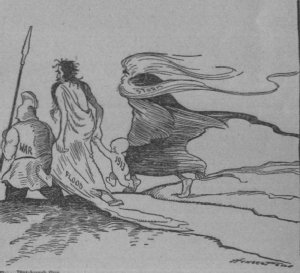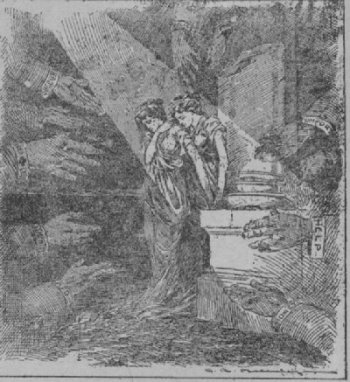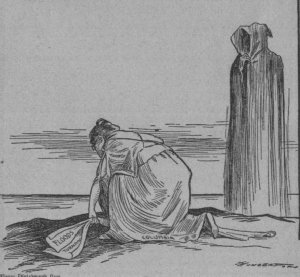HISTORY OF CITIES
OHIO COMMUNITIES ENGULFED ARE AMONG OLDEST IN NORTHWEST TERRITORY.
The Great Miami river, responsible for most of the deaths in the flood which swept Ohio, rises in Hardin county and flows southward for a distance of about 150 miles.
The Great Miami flows through Troy, Dayton, Hamilton and a score of smaller towns, entering the Ohio river at the southwest corner of the state, 20 miles west of Cincinnati.
Geographically speaking, the Great Miami is one of the most peculiar streams in the United States. It flows rapidly through a very fertile country which extends for miles hardly a foot above the ordinary high water level.
The Great Miami is navigable only for a small part of its length. The Miami canal runs along the river for a distance of 70 miles, passing through Dayton and Hamilton, and through this canal freight barges are operated. The Mad, Whitewater and West Branch rivers flow into the Great Miami, and ordinary floods occur almost every spring along the valleys through which they flow.
Dayton, Ohio, is the county seat of Montgomery county, and had a population of 116,577, according to the census of 1910. It is situated at the confluence of the Great Miami and Mad rivers and Stillwater and Wolf creeks. Four railroad lines pass through the city and 125 trains enter the city daily at the new union station, which was finished in 1900 at a cost of $900,000. The city has an area of 16½ square miles.
Dayton’s manufacturing interests are widely diversified and include the manufacture of cash registers, railroad and street cars, scales, agricultural implements, water wheels, sewing machines and foundry products. Many establishments employ from five hundred to twenty-five hundred hands. The United States census of 1910 gave the average number of wage earners as 23,754. The total wages paid a year aggregate ten million dollars and the value of the products almost seventy-five million dollars.
Dayton has more interurban traction lines than any other city in Ohio; there are nine lines radiating in all directions from the city and having a combined mileage of more than seven hundred miles. Dayton has excellent schools, libraries and hospitals.
The town was laid out in November, 1795, by Gen. Israel Ludlow, and was named after Gen. Jonathan Dayton. The first settlers arrived in the spring of 1796. Situated in the midst of a fertile agricultural region and the center of a gigantic trade territory, Dayton grew to be the third largest manufacturing city in Ohio. It also is one of the richest cities per capita in the middle west.
Dayton has been called the home of the cash register, of the computing scale, the interurban car and the aeroplane. The Wright brothers did their pioneering work in aviation in the neighborhood of Dayton, and manufactured their machines and had their school of aviation there. The National military home for disabled volunteers is at Dayton.
Hamilton, Ohio, is the county seat of Butler county, 82 miles southwest of Dayton and 15 miles north of Cincinnati. The town is on the Great Miami river and the Miami and Erie canal. It has a population of 35,000. Hamilton was founded in 1791 by Gen. Arthur St. Clair and named in honor of Alexander Hamilton. It was incorporated as a town in 1810.
The excellent water power has been of great advantage in the development of the city and has made manufacturing the city's chief industry. The chief manufactures are flour, paper, beer, woolen goods, agricultural implements, machinery and tools. Heavy trade also is carried on in tobacco, hay, grain and vegetables.
 |
Middletown, Ohio, another of the flood-stricken towns, is in Butler county on the Great Miami river and the Miami and Erie canal, about 34 miles north of Cincinnati. It, too, was the center of an agricultural section, but water power transformed the place and made it a manufacturing town. Its principal products have been bicycles, agricultural implements, paper, flour, dairy products and tobacco products. The population of Middletown is 13,000.
Other towns along the Great Miami river and the Miami and Erie canal between Dayton and where the Great Miami empties into the Ohio, are West Carrollton, Miamisburg, Franklin and Cleves; West Carrollton and Miamisburg are villages a short distance south of Dayton, formed for the greater part of manufacturing establishments and those employed in them.
Piqua, Ohio, has a population of 13,350, and is located 28 miles northwest of Dayton. Because of its aboundant water power it is noted as a manufacturing center. Large woolen mills and factories for making tools, carriages and furniture and stoves are located there. It also has a large stone quarry.
 |
Drawn by Macaulay |
DRIFTWOOD TALES
DAYS AND NIGHTS WITH THOUSANDS MAROONED IN MIDST OF WATERS—HORSES IN NATIONAL BANK—GIRL RESCUES TWENTY-SEVEN—DROWNED MAN "COMES TO LIFE."
Rescuers went through the parish of Emanuel church at Dayton, distributing ham sandwiches and other food to the famished flood victims.
"We will not eat ham sandwiches," said some of them. "This is Friday."
Father Sieber held aloft a sandwich and said, "It is all right to eat this," and suited the action to the word. He invoked a rule of the church which permits the suspension of certain religious obligations in time of stress.
Four horses enjoyed shelter in the Fourth national bank building, as safe and sound as the currency in its vaults. Some of the people to whom they owe their lives are dead. Before the flood reached its apex, the horses were taken into the bank. The people who saved them returned to more rescue work.
A woman in the upper story of a house in the flooded district on lower Fifth street turned down a box of fancy baked goods, and begged a relief party to give her "just one loaf of rye bread instead."
Her wish was granted.
Among the heroines was Mary Costello, daughter of Frank Costello, paper manufacturer. With a clothes line she rescued 27 women and children, who were dragged into an upper-story window at the Costello home.
Sister Helen of the Notre Dame convent in North Dayton saved 70 persons from the flood by throwing a rope from a window and then pulling refugees in off debris and out of the water. All the sisters in the convent were saved. The nuns prayed aloud while the water was creeping higher and higher on the walls of the convent.
A dozen telephone girls down at Miamisburg, below Dayton, stuck to their posts and were marooned above a grocery. They managed to cut a hole through the floor, and with lines fished canned goods and loaves of bread from the water in the store. On this food they lived for two days.
Mrs. Frank Carnell, worth millions and part owner of the National Cash Register Co., sent an appeal to the relief workers at the big plant asking that food be sent to her, as she was marooned in her home. The same boat in which her food supply was sent also carried supplies to Mary Smith, poor negress, prisoner in a humble frame building.
Clerks in the postoffice building found an old tank of water that could be made fit to drink by boiling. They had no fuel, but by shouting to the men and women in the Cappel building across the street a trade was arranged. The cappel building refugees threw ropes to the postoffice and sent over some fuel. The clerks boiled the water and sent a quantity of it to their friends across the way, who were half dead with thirst.
Refugees throughout the business section established a means of communication by stretching ropes from building to building. Those better supplied with food sent provisions in this way to their less fortunate neighbors.
The body of a woman was found hanging to a chandelier in a house at the foot of Morton street. She had been caught by the flood without a chance of escape, lifted up to the ceiling and drowned.
C. A. Turney, of Columbus, Ohio, removed as dead to the temporary morgue in Greenlawn cemetery, "came to life" last night.
A small boy standing beside the supposed corpse, shrieked. A doctor came running, restoratives were applied, and Turney spoke. He told how he was washed away from his family and floated to a tree on Greenlawn avenue. He hitched himself to the trunk with harness straps that drifted to him, and he remained there until cut down as dead.
Richard Filley, 3203 W. 82d street, Big Four railroad conductor, the first Cleveland refugee of the Dayton flood to return home told the story of how he, with 115 passengers, 40 of them women, was marooned for two days and two nights on the top floor of the union station while water 12 feet deep surrounding the building.
A kind fate seemed to hover over the entire party, Filley says. None was drowned and never at any time were they without food or water.
"I left Cleveland at 9 p. m. aboard train No. 26, bound for Cincinnati, where we were due to arrive at 5 a. m. Tuesday," said Filley at his home. "We ran late, however, and it was 4:55 a. m. Tuesday when we crossed the Great Miami bridge at Dayton. We were flagged as we approached the depot. The tracks beyond Dayton were in such bad shape that the dispatcher feared to let us proceed.
"We stood there just across the bridge until 8:30 a. m. The river was rising at a rapid rate, but no one had any fear. Finally the water covered the tracks, and then orders came quickly. Passengers on a Pennsylvania train lying alongside were loaded onto our cars and we were told to run into the depot. As we got alongside the shed the fires were put out in the engine by the flood. Water around us was waist deep.
"We then started lifting passengers up onto the train shed, and boosting them from there into the upper windows of the depot. We threw ropes to six men in a Cincinnati, Hamilton & Dayton train 125 feet away. They tied these around their waists and we pulled them to the shed.
"In the same way we rescued three men who had gone to sleep in the caboose of another train.
"The kitchen of the depot restaurant was on the second floor, and we had food for that day and night. The rain kept pouring down.
"Ludlow street was a rushing, mad river. It carried pianos, tables, horses, wagons and small houses along with it. A man who refused to leave a little railway shanty when warned was drowned inside his coop.
"By Wednesday morning we seemed to be in the midst of an ocean. Scores of houses were floating quietly down the river. They were piled up against the Miami bridge until it finally gave way.
"Wednesday night the storm reached its climax. The rain fell as from a hose. Lightning flashed and thunder crashed. Then the worst of the fires broke out and from our windows we could see flames shooting 50 feet into the air. Both men and women knelt on the floors and prayed out loud. One man, a member of a theatrical troupe lost his mind completely and we had to place him under guard.
"‘We’re goners,’ a man said to me, and I was ready to believe him. Everyone thought the world had come to an end.
"Thursday morning brought relief, however, and as it began to get colder the water began to recede rapidly. We saw land during the day and by Friday morning the river was inside its banks.
"Kirk Conley, C. H. & D. conductor, Mike Kelley, Pennsylvania conductor, operator O’Neil and a negro porter whose name I did not learn were the heroes of the party. They never lost their nerve, and led the men who got our food and water for us.
"Our food came from the debris which floated on the water. We had apples, ham, succotash, sausages and bananas."
 |
By BISHOP DAVID H. GREER. "Oh merciful God and heavenly Father, who has taught us in Thy Holy Word that Thou dost not willingly afflict or grieve the children of men, give ear to the prayers which we humbly offer to Thee in behalf of our brethren who are suffering from the great water floods. "Cause them in their sorrow to experience the comfort of Thy presence, and in their be- wilderment the guidance of Thy wisdom. "Stir up, we beseech Thee, the wills of Thy people to minister with generous aid to their present needs, and so overrule in Thy Provi- dence this great and sore calamity that we may be brought nearer to Thee and be knit more closely one to another in sympathy and love. All which we humbly ask through Jesus Christ our Lord. Amen." |
Back
Back to Legacy